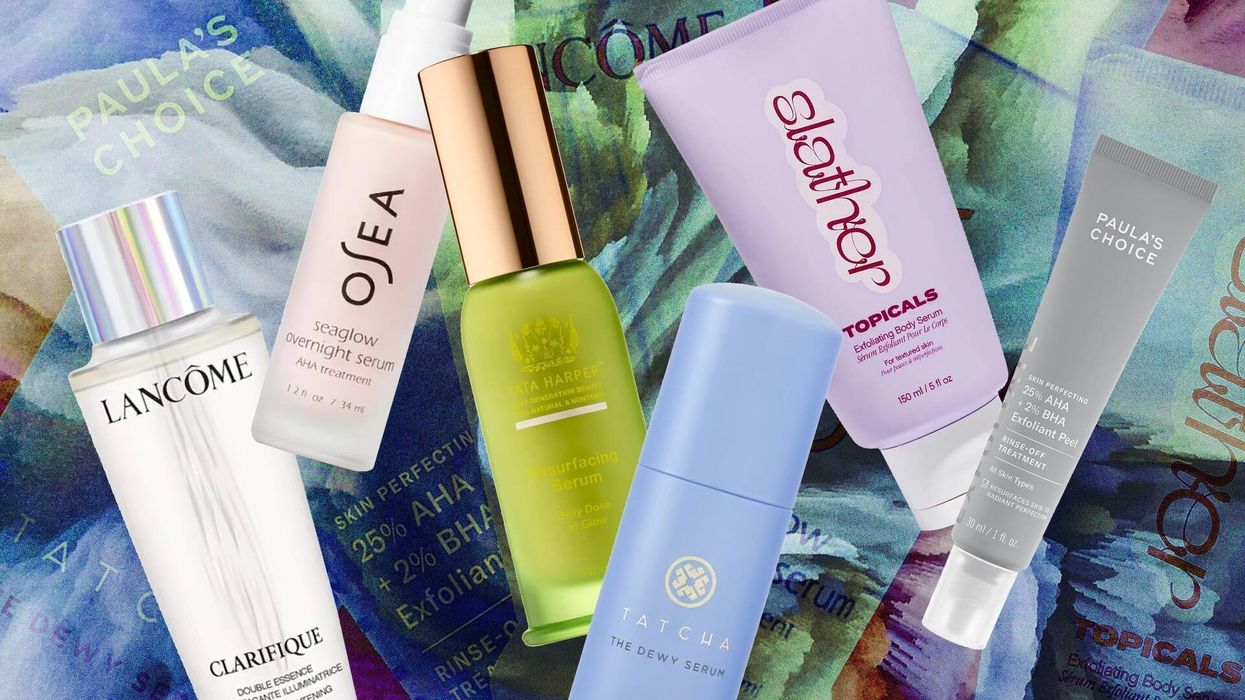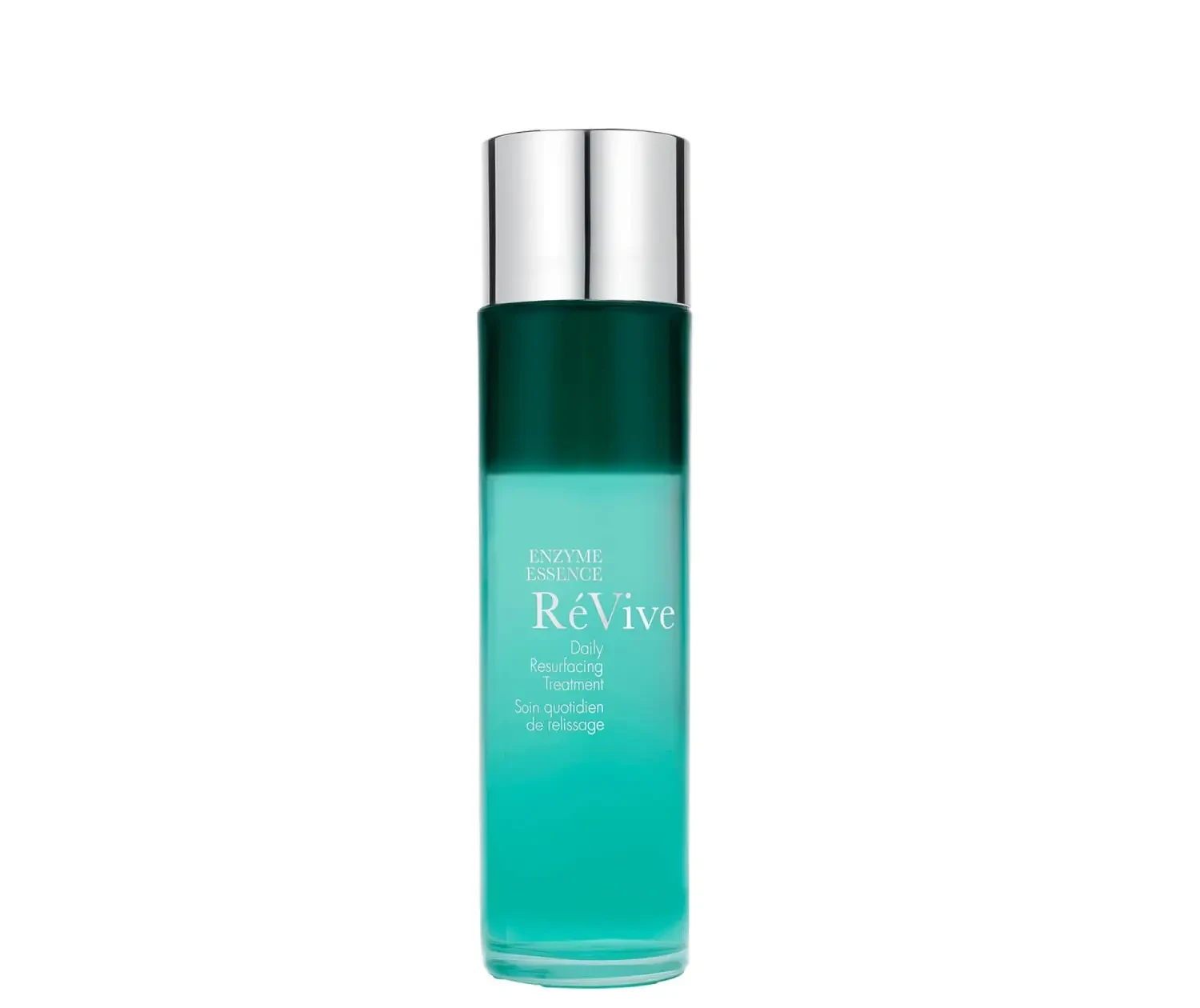Wrinkles, Dark Spots & Acne: They’re No Match for Alpha Hydroxy Acids
Everything you need to know about the powerhouse exfoliating ingredient.

When I think about alpha hydroxy acids—or AHAs, as they’re also known—I'm instantly transported to my college dorm room with nothing but a student ID and a bottle of The Ordinary's AHA Peeling Solution to my name. I can still feel the tingling sensation from my many—admittedly incorrect—administrations of the cult favorite vampy peel. But as many experts can point out, AHAs extend far beyond that $8 bottle of peeling solution. In fact, they are one of the most versatile chemical exfoliants on the market, with varying intensities ranging from professional-only usage to middle-schooler-friendly. Given the wide range of skincare concerns AHAs can target, including fine lines, hyperpigmentation, and preventing blemishes, it's no surprise that they have reached GOAT status within the skincare industry.
Read on to learn more about the superstar ingredient and how to add it to your current skincare routine.
What are alpha hydroxy acids?
Alpha hydroxy acids are one in a bevy of time-tested skincare acids, classified by their water solubility, which allows AHAs to target and exfoliate the surface area of the skin by encouraging "skin cell turnover," explains board-certified dermatologist Dr. Hope Mitchell.
"AHAs work by gently separating the top layer of old skin cells through breaking up the ‘glue’ that holds these cells together. This stimulation prompts new layers of skin to rise to the surface after the accelerated turnover of skin cells," says Dr. Mitchell. AHAs are naturally occurring and found in food sources including "milk, sugar cane, and apples," says board-certified dermatologist Dr. Hamdan Abdullah Hamed. However, AHAs used in dermatologic and cosmetic products are often synthetic.
Lactic and glycolic acid are among the most famed AHAs within the beauty space. Citric, malic, mandelic, and tartaric acids are also commonly used AHAs. While all AHAs offer some form of exfoliation, the intensity varies based on the type and concentration. "Glycolic acid [which is used in at home and professional peels] is known for effective exfoliation, while lactic acid is gentler and hydrating," says Dr. Mitchell.
Benefits of alpha hydroxy acids for skin
AHAs are most known for their chemical exfoliating properties, an ace component in most at-home and professional-grade peels, especially for those looking to target hyperpigmentation and discoloration.
"AHAs are what cause the skin to peel in peeling products, so an even application over the skin would allow for a uniform brightening and exfoliation," says Dr. Hamed. But don't let the exfoliation talk fool you; AHAs can also aid in hydration since they are also humectants, meaning they draw and cohere water to the skin, which Dr. Mitchell explains, lends AHAs to "visibly enhance skin radiance and diminish the appearance of fine lines and wrinkles.”
What's the difference between alpha hydroxy acids and other acids?
Unlike other fan-fave acids such as beta hydroxy acids (BHAs), which include tropic and salicylic acids, AHAs target exfoliation at the surface while BHAs get deeper into the skin.
This surface-level exfoliation makes AHAs especially clutch in reversing the visible effects of aging and promoting the appearance of a youthful glow, says Dr. Mitchell. "Through its support of skin rejuvenation, consistent use of alpha hydroxy acids can contribute to improving the overall health and youthfulness of your skin," says Dr. Mitchell.
What are the potential side effects of using alpha hydroxy acids?
One of the main areas of concern when it comes to AHAs is the risk of over-exfoliation, which can lead to a host of adverse consequences, explains Dr. Hamed. "These issues can range from skin irritation and dermatitis to swelling and color changes since excessive use can cause darkening of the skin," says Dr. Hamed. Excessive use can also increase proneness to sunburns and sun damage as over-exfoliation makes the skin "more sensitive to heat," says Dr. Hamed.
Furthermore, those with skin conditions such as eczema or psoriasis should exercise particular caution as this "can make the skin thinner and more delicate," says Dr. Hamed.How should you incorporate alpha hydroxy acids in your skincare routine? What ingredients pair well with alpha hydroxy acids? Which ingredients don't pair well?
The list of ways to incorporate AHAs into your skincare routine is longer than a CVS receipt, making it one of the most straightforward products to add to your routine. From cleansers and moisturizers to peels and serums, the limit does not exist. If you are utilizing a peel, Dr. Mitchell says it's important not to use any other products with AHA's in close succession.
"You can use an at-home chemical peel on a weekly basis, but please remember not to use it on the same day as your regular AHA exfoliant or retinol," says Dr. Mitchell. Save for circumstances where the ingredients are formulated together, experts say you should avoid using vitamin C, retinoids, and benzoyl peroxide during the same day you are using an AHA. Conversely, hydrating ingredients such as ceramides, glycerin, and hyaluronic acid are great barrier buddies to pair with AHAs.
Before making AHAs a staple in your routine, Dr. Mitchell always advises a patch test. "Before applying any AHA product all over the face, a patch test on a small area is recommended to check for adverse reactions," says Dr. Mitchell, who also adds that this is not the product to keep around past its expiration date. "Pay attention to the product's expiration date, as AHA products can lose their effectiveness over time," says Dr. Mitchell.
With all this in mind, let's get into the best in AHAs, from total body cleansers to overnight glow serums.
Best Alpha Hydroxy Acid Skincare Products
Clarifique Exfoliating & Hydrating Face Essence with Glycolic Acid

Skincare essences are my most recent endeavor, and this clarifying essence from Lancôme embodies all of the qualities I've been looking for — a hydrating, pore-minimizing product that I can use to prep my face for the ultimate beat or apply as a finishing step in my evening routine. With glycolic acid (AHA) and salicylic acid (BHA) starring as premier ingredients, this essence is perfect for those looking to gently resurface their skin without sacrificing moisture.
Skin Perfecting 25% AHA + 2% BHA Exfoliant Peel

For the DIY lovers out there, this skin-perfecting peel from Paula's Choice proves two things: 1.) At home-peels can be relatively stress-free, and 2.) different acid classes can play quite nicely together. The AHAs target advanced signs of aging, with the BHAs swooping in to unclog enlarged pores.
Seaglow Overnight Serum AHA Treatment

Formulated with 9% AHAs, including malic, lactic, citric, and tartaric acid, this serum gently but effectively exfoliates and hydrates your skin while you sleep.
Resurfacing & Brightening AHA + BHA Serum with Vitamin C

Another dual-acid product, this exfoliating and brightening serum from Tata Harper contains a "superfruit" concoction of AHAs, including lactic, glycolic, citric, malic, and tartaric acids. This serum also has key brightening ingredients like vitamin C, and skin texture-smoothing BHAs work like a peel to resurface the outermost layer of the skin, leaving a more even-toned skin in its wake.
Enzyme Essence Daily Resurfacing Treatment

This lightweight essence from Révive combines their signature bio-renewal peptide with various enzymes, including pineapple, a natural AHA source that catalyzes exfoliation and works to even out the complexion. This is an excellent addition for those who already have a solid skincare routine but are looking to take it to the next level.
The Dewy Serum Resurfacing and Plumping Treatment

Plump and dewy adequately summarize how I want my skin described, and if this resonates with you, then this exfoliating and plumping treatment by Tatcha is a must-have. Formulated with lactic acid (an AHA) and hyaluronic acid, a humectant that aids in attracting and keeping the skin hydrated, this treatment visibly plumps the skin, improving both radiance and texture.
The Smoother Glycolic Acid Exfoliating Body Wash

One of my biggest beauty resolutions this year was to give the skin below my neck the same time and energy I pour into my face on a regular basis. And what better way to start than with a body wash? Specifically, with this glycolic acid-infused exfoliating body wash from Natrium which cleanses and resurfaces dry and bumpy skin. The perfect way to kick off a total body skincare routine.
Slather Exfoliating Body Serum with Retinol and AHAs

Following the theme of taking body skincare seriously I realized that if I'm going to use a serum on my face then my body probably needs one too. This exfoliating body serum from Topicals was an immediate add to cart once I learned that it worked as a chemical exfoliant for the whole body, thanks to our trusted lactic and glycolic AHAs as well as encapsulated all-trans-retinol. Retinol for the whole body? Count me in.




